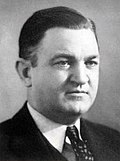| |||||||||||||||||
| |||||||||||||||||
 County results Bailey: 50–60% 60–70% 70–80% 80–90% >90% | |||||||||||||||||
| |||||||||||||||||
| Elections in Arkansas |
|---|
 |
The 1938 Arkansas gubernatorial election was held on November 8, 1938, in order to elect the Governor of Arkansas. Incumbent Democratic Governor of Arkansas Carl E. Bailey defeated Republican nominee Charles F. Cole. [1]

